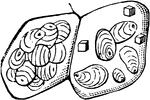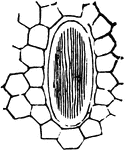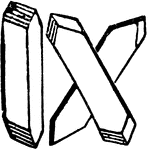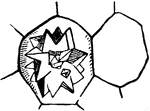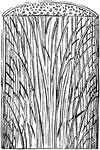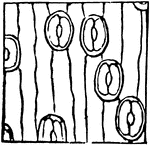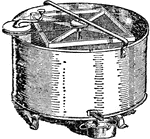
Hruschka Extractor
"Hruschka's extractor, first brough to public notice in 1865, may be said to have revolutionized the…

Womans Bike
"A lady's bicycle with gear-case and dress-guard. The rear frame of the "diamond" type is subjected…

Bone Section
Longitudinal section of bone, a microscopic view. 1: Cells; 2: Canals; 3: Intercellular substance.

Bone Section
Cross-section of bone, a microscopic view. 1: Cells; 2: Canals; 3: Intercellular substance.
Nervous System
Element of Nervous System. a: Sensory fiber; b: Motor fiber; c: Center; f: End of sensory fiber; m:…
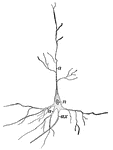
Nerve Cell
Nerve cell from the brain; a, processes by which it communicates with other cells near by;…
Sexual Organ of Insects
Ovarian tubes of one side, in Polistes, showing eggs in all stages of development, with nutritive…
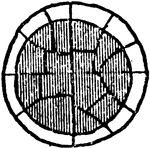
Bryophyta
Riccia. Semi-diagrammatic figure of a young embryo of Liverworts in longitudinal section. The cells…
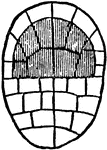
Bryophyta
Marchantia morpha. Semi-diagrammatic figure of a young embryo of Liverworts in longitudinal section.…

Bryophyta
Pellia epiphylla. Semi-diagrammatic figure of a young embryo of Liverworts in longitudinal section.…
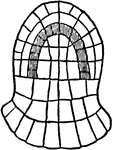
Bryophyta
Anthoceros laevis. Semi-diagrammatic figure of a young embryo of Liverworts in longitudinal section.…

Bryophyta
Cephalozia bicuspidata. Semi-diagrammatic figure of a young embryo of Liverworts in longitudinal section.…
Bryophyta
Radula complanaia. Semi-diagrammatic figure of a young embryo of Liverworts in longitudinal section.…

Bryophyta
Marchantia polymorpha. Air-chamber with the filaments of assimilating cells and stoma in vertical section
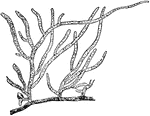
Bryophyta
Funaria hygrometrica. Part of a developed protonema. h, Creeping filament with brown walls from which…

Stamen of Pentstemon
Stamen of Pentstemon pubescens; the two-anther-cells diverging, and almost confluent.

Stamen of Mallow
Stamen of Mallow; the anther supposed to answer to that of Pentstemon pubescens, but the cells completely…

Stamens
Stamens of the mint family. Of a Monarda: the two anther-cells with bases divergent so that they are…
Formation of the Embryos
Figures to illustrate the earlier stages in the formation of an embryo; a single mass of protoplasm…
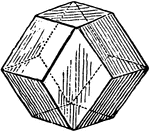
Vegetable Cell
Diagram of a vegetable cell, such as it would be if when spherical it were equally pressed by similar…

Calla Lily
Magnified view of a portion of a transverse slice of stem of Calla Lily. The great spaces are tubular…
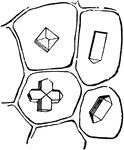
Onion-Peel
Four cells from dried Onion-peel, each holding a crystal of different shape, one of them twinned.

Rhubarb-plant
Some cells from stalk of Rhubarb-plant, three containing chlorophyll; two (one torn across) with rhaphides.
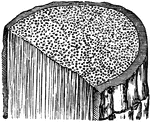
Palm-stem
A Palm-stem in transverse and longitudinal section, the dots on the cross sections represent cut ends…
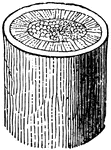
Stem of Flax
Short piece of stem of Flax, magnified, showing the bark, wood, and pith in a cross section.

Piece of Stem from a Soft Maple
Piece of a stem of Soft Maple, of a year old, cut crosswise and lengthwise.

Bit of Young Maple Wood
Magnified view of surface of a bit of young Maple wood from which the bark has been torn away, showing…

White Lily
Magnified section of a leaf of White Lily, to exhibit the cellular structure, both of upper and lower…
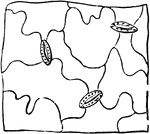
Garden Balsam
Small portion of epidermis of the Garden Balsam, showing very sinuous-walled cells, and three stomata.
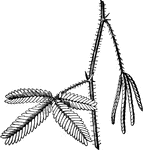
Sensitive Plant
Piece of stem of Sensitive Plant (Mimosa pudica), with two leaves. the lower open, the upper in the…

Telegraph-plant
Portion of stem and leaves of Telegraph-plant (Desmodium gyrans), almost of natural size.










